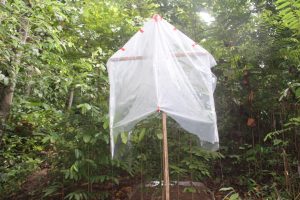
Connection between drought and climate change experiment 50HA plot SEARRP
The results of the study found that all seedlings responded to drought, but that seedlings in more diverse groups had less water stress than seedlings in monocultures after a severe drought. In addition, seedlings in the diverse groups maintained their growth similar to seedlings that never experienced drought. Therefore, complementary interactions among multiple species delayed the point at which water limited growth. Because seedling growth determines the future forest structure, these results demonstrate the importance of plant diversity for promoting drought resistance in tropical forests.
These findings have two major implications for our understanding of tropical forests under climate change. First, diversity promotes tree resistance to drought in tropical forests, which is important because drought is predicted to become more frequent and severe under climate-change scenarios. Second, because seedlings in monoculture neighborhoods were more inhibited by reduced water, drought has a role in driving diversity in tropical forests by reducing the success of seedlings in areas with low diversity. This indicates that a feedback exists whereby drought encourages diversity and diverse forests are more resistant to drought. However, this also means that biodiversity loss reduces the resistance of forests to drought which in turn can lead to further biodiversity loss. To prevent this reverse feedback loop, it is essential to conserve biodiversity in tropical forests — both by maintaining existing diverse forests and by using diverse seed mixtures when planting new forests during restoration. Using such diversity strategies will improve forest resistance to climate change.
Read the full paper here: Resistance of tropical seedlings to drought is mediated by neighbourhood diversity
